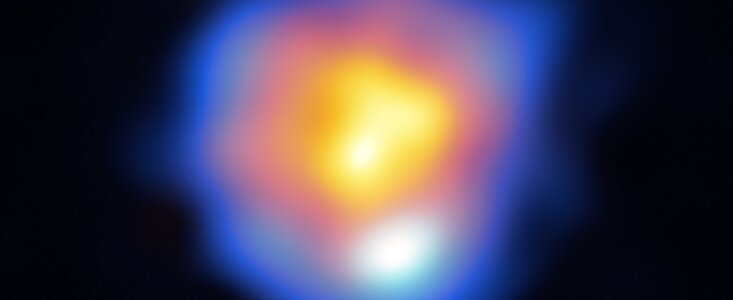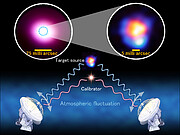Ogłoszenie
ALMA achieves its highest resolution observations
15 listopada 2023
The Atacama Large Millimeter/submillimeter Array (ALMA), in which ESO is a partner, has achieved the highest resolution observations since it began operations. During a technical test, a team of experts from the Joint ALMA Observatory (JAO) in Chile, the National Astronomical Observatory of Japan (NAOJ), National Radio Astronomy Observatory (NRAO) in the USA, and ESO, imaged an evolved star with a resolution of 5 milliarcseconds. This shows ALMA can be used by astronomers to observe objects in detail equivalent to seeing a 10-metre-long bus on the Moon.
ALMA consists of 66 antennas which can be arranged in different positions across the high-altitude Chajnantor plateau in Chile. Each is equipped with receivers that allow it to observe radio waves in different frequency ranges, or bands. ALMA’s resolution increases both as the maximum separation between antennas increases and as the frequency of the observations increases. The new images were obtained with the most extended configuration possible for the ALMA array, with a maximum separation between its antennas of 16 km. They were made using the Band 10 receivers, which allow ALMA to observe at frequencies as high as 950 GHz, the highest possible for the array.
Since the observations push ALMA’s capabilities to the extreme, they were incredibly challenging to conduct. While Band 10 receivers have been available at ALMA since 2014, astronomers had to wait for the validation of a novel calibration technique, called band-to-band, to be able to conduct the new observations. They did so during a technical test in 2021 when they observed an evolved Milky Way star, R Leporis, using a bright galactic core as a calibrator, which, while distant, appears nearby R Leporis in the sky. The results are published today in the Astrophysical Journal.
This result has been achieved with significant support from ESO staff, who were involved in the test observations, the previous experiments in the lead up to this final technical achievement, and the development of the new calibration technique.
More Information
This result was presented in a paper titled “ALMA High-frequency Long Baseline Campaign in 2021: Highest Angular Resolution Submillimeter Wave Images for the Carbon-rich Star R Lep” to appear in the Astrophysical Journal (doi:10.3847/1538-4357/acf619).
The team is composed of Y. Asaki (JAO; NAOJ; SOKENDAI), L. Maud (ESO; Leiden University), H. Francke (JAO), H. Nagai (NAOJ), D. Petry (ESO), E. B. Fomalont (NRAO), E. Humphreys (JAO; ESO), A. M. S. Richards (University of Manchester), K. T. Wong (IRAM; Uppsala University), W. Dent (JAO), A. Hirota (JAO; NAOJ), J. M. Fernandez (Lowell Observatory), S. Takahashi (NAOJ), and A. S. Hales (JAO; NRAO).
A previous technical study, leading to the 2021 Campaign can be found in: “ALMA High-frequency Long-baseline Campaign in 2019: Band 9 and 10 In-band and Band-to-band Observations Using ALMA's Longest Baselines”, published in the Astrophysical Journal in August 2023 (doi: 10.3847/1538-4365/acd6f1).
ALMA is a partnership of ESO (representing its member states), NSF (USA) and NINS (Japan), together with NRC (Canada), NSTC and ASIAA (Taiwan), and KASI (Republic of Korea), in cooperation with the Republic of Chile. The Joint ALMA Observatory is operated by ESO, AUI/NRAO and NAOJ.
Linki
Kontakt
Luke Maud
ALMA Regional Centre at ESO
Garching bei München, Germany
Tel: +49 89 3200 6765
Email: Luke.Maud@eso.org
Bárbara Ferreira
ESO Media Manager
Garching bei München, Germany
Tel: +49 89 3200 6670
Email: press@eso.org
O ogłoszeniu
| Identyfikator: | ann23019 |
Our use of Cookies
We use cookies that are essential for accessing our websites and using our services. We also use cookies to analyse, measure and improve our websites’ performance, to enable content sharing via social media and to display media content hosted on third-party platforms.
ESO Cookies Policy
The European Organisation for Astronomical Research in the Southern Hemisphere (ESO) is the pre-eminent intergovernmental science and technology organisation in astronomy. It carries out an ambitious programme focused on the design, construction and operation of powerful ground-based observing facilities for astronomy.
This Cookies Policy is intended to provide clarity by outlining the cookies used on the ESO public websites, their functions, the options you have for controlling them, and the ways you can contact us for additional details.
What are cookies?
Cookies are small pieces of data stored on your device by websites you visit. They serve various purposes, such as remembering login credentials and preferences and enhance your browsing experience.
Categories of cookies we use
Essential cookies (always active): These cookies are strictly necessary for the proper functioning of our website. Without these cookies, the website cannot operate correctly, and certain services, such as logging in or accessing secure areas, may not be available; because they are essential for the website’s operation, they cannot be disabled.
Functional Cookies: These cookies enhance your browsing experience by enabling additional features and personalization, such as remembering your preferences and settings. While not strictly necessary for the website to function, they improve usability and convenience; these cookies are only placed if you provide your consent.
Analytics cookies: These cookies collect information about how visitors interact with our website, such as which pages are visited most often and how users navigate the site. This data helps us improve website performance, optimize content, and enhance the user experience; these cookies are only placed if you provide your consent. We use the following analytics cookies.
Matomo Cookies:
This website uses Matomo (formerly Piwik), an open source software which enables the statistical analysis of website visits. Matomo uses cookies (text files) which are saved on your computer and which allow us to analyze how you use our website. The website user information generated by the cookies will only be saved on the servers of our IT Department. We use this information to analyze www.eso.org visits and to prepare reports on website activities. These data will not be disclosed to third parties.
On behalf of ESO, Matomo will use this information for the purpose of evaluating your use of the website, compiling reports on website activity and providing other services relating to website activity and internet usage.
Matomo cookies settings:
Additional Third-party cookies on ESO websites: some of our pages display content from external providers, e.g. YouTube.
Such third-party services are outside of ESO control and may, at any time, change their terms of service, use of cookies, etc.
YouTube: Some videos on the ESO website are embedded from ESO’s official YouTube channel. We have enabled YouTube’s privacy-enhanced mode, meaning that no cookies are set unless the user actively clicks on the video to play it. Additionally, in this mode, YouTube does not store any personally identifiable cookie data for embedded video playbacks. For more details, please refer to YouTube’s embedding videos information page.
Cookies can also be classified based on the following elements.
Regarding the domain, there are:
- First-party cookies, set by the website you are currently visiting. They are stored by the same domain that you are browsing and are used to enhance your experience on that site;
- Third-party cookies, set by a domain other than the one you are currently visiting.
As for their duration, cookies can be:
- Browser-session cookies, which are deleted when the user closes the browser;
- Stored cookies, which stay on the user's device for a predetermined period of time.
How to manage cookies
Cookie settings: You can modify your cookie choices for the ESO webpages at any time by clicking on the link Cookie settings at the bottom of any page.
In your browser: If you wish to delete cookies or instruct your browser to delete or block cookies by default, please visit the help pages of your browser:
Please be aware that if you delete or decline cookies, certain functionalities of our website may be not be available and your browsing experience may be affected.
You can set most browsers to prevent any cookies being placed on your device, but you may then have to manually adjust some preferences every time you visit a site/page. And some services and functionalities may not work properly at all (e.g. profile logging-in, shop check out).
Updates to the ESO Cookies Policy
The ESO Cookies Policy may be subject to future updates, which will be made available on this page.
Additional information
For any queries related to cookies, please contact: pdprATesoDOTorg.
As ESO public webpages are managed by our Department of Communication, your questions will be dealt with the support of the said Department.


